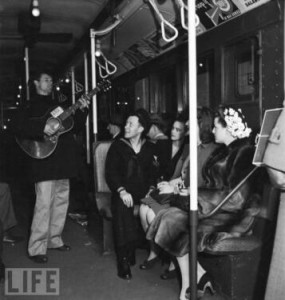Fun Night of Live Music with Mona’s Hot Four
 This past Tuesday night I had a great time at the Rockwood Music Hall for a combined launch of a new documentary and CD. The film is called “Tuesday at Mona’s” as is the new CD, a live recording, and they feature a jazz quartet called Mona’s Hot Four, who have a long-running weekly gig on Manhattan’s Lower East Side at Mona’s Bar on Avenue B between 13th and 14th streets. The basic outfit is clarinet, piano, stand-up bass, and guitar, and is regularly supplemented by additional players on various instruments.
This past Tuesday night I had a great time at the Rockwood Music Hall for a combined launch of a new documentary and CD. The film is called “Tuesday at Mona’s” as is the new CD, a live recording, and they feature a jazz quartet called Mona’s Hot Four, who have a long-running weekly gig on Manhattan’s Lower East Side at Mona’s Bar on Avenue B between 13th and 14th streets. The basic outfit is clarinet, piano, stand-up bass, and guitar, and is regularly supplemented by additional players on various instruments.
This launch had originally been planned for the week Superstorm Sandy hit NYC, but was of course canceled. Mona’s frontman, clarinetist Dennis Lichtman reported that Rockwood was forced to cancel 81 shows because of Sandy. They were able to reschedule, and the boisterous crowd did not seem at all diminished by the change. Just after 8 PM a film screen was unrolled on stage, and a projector was clicked on to screen the new documentary. About 30 minutes long, the film tells the feel-good story of how an eclectic tribe of jazz players ended up finding at Mona’s the ideal venue and audience for their passionate enthusiasms for tunes of the halcyon pre-bop era. There are several extended songs and a number of interviews with musicians, fans, bartenders, and Wall St. Journal jazz critic Will Friedwald, who touted Mona’s Hot Four and the scene at the bar in an 2011 diary-like piece, “After Midnight at Mona’s”:
11:30 p.m. Within a few numbers (“Margie,” “Blues My Naughty Sweetie Gives to Me”), it’s abundantly clear that this group is immersed in the early New Orleans jazz idiom…. 1 a.m. The room is packed with young men sporting beards and slender women with Bettie Page bangs and abundant tattoos. There must be 100 people crammed inside this tiny bar, with seats for maybe 15, and only a fraction of those either sitting or standing can actually see the band. The room is dense with young musicians carrying instrument cases, or wearing their saxes around their neck, waiting to be called. “I think it’s amazing that we’ve become a mecca for those who love this music,” Mr. Lichtman says….2:30 a.m. The band is starting to thin out, and plays two numbers just to delight the record collectors in the crowd, “Dardanella” and “Hang Out the Stars in Indiana,” the latter fetchingly sung by Ms. [Molly] Ryan.
Once the film ended, Mona’s Hot Four took the stage, with clarinetist Lichtman introducing his band mates: Gordon Webster (piano), Jared Engel (bass), and Nick Russo (guitar). Their playing is a joy to hear with clear melodic lines on standards like “My Blue Heaven,” tasty licks on “Sugar Blues,” and fluent ensemble work on “Up a Lazy River.” Though Rockwood is not the Hot Four’s usual venue, many additional players showed up to supplement the quartet. In the set that followed the documentary, they were joined on stage by a caravan of players on trombone, trumpet, banjo, snare drum, and a number of talented vocalists. Among this retinue was singer the aforementioned Molly Ryan and banjo player and vocalist Jerron Paxton.
Lichtman fronts another group, Brain Cloud, which I had enjoyed and posted about during the Brooklyn Folk Festival last May. I hope I have another chance to hear them sometime, as they have a semi-regular gig at the Rodeo Bar in Manhattan. That group also plays some jazz, though with a different flavor than Mona’s Hot Four, as well as Western swing, klezmer, and songs from Tin Pan Alley, with vocalist Tamar Korn (who also sang with Mona’s Hot Four this week). After the documentary and an abbreviated set of music, Lichtman announced that Mona’s Hot Four would later that night they’d be camped out at Mona’s Bar for their usual late Tuesday night set. I wasn’t able to migrate to Mona’s on this night, but I do hope to hear them there some other week. If you’d like to buy the DVD/CD which includes the documentary and live album in one package, you can order it via this link, and listen to some of the Monas’ hot stuff.
Here’s a 2010 video of Mona’s Hot Four I just found online:
On my way back uptown, I stopped in at another great spot, the 11th Street Bar, to hear what live music they might have on in their back room. I was delighted to discover a band there led by guitarist Teddy Kumpel, whose band of drums, bass, and another lead guitar, was having fun playing an infectious melange of funk and blues. You can hear a sample of his groove at this page on his website. Please click through on this link to see all photos I took during this fun night of live music.







